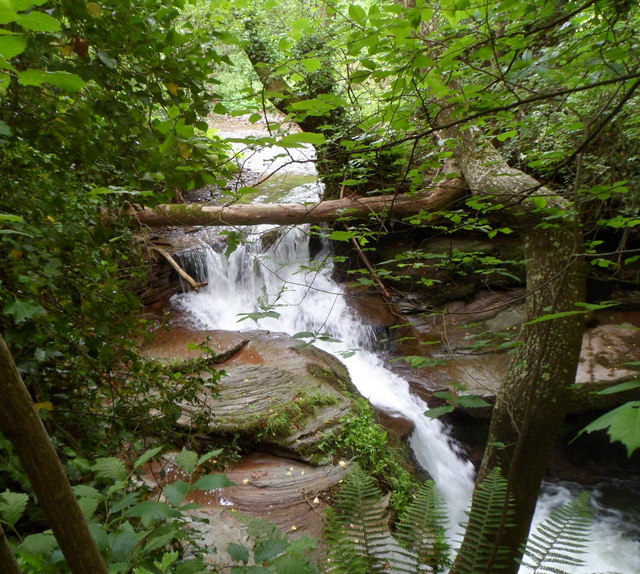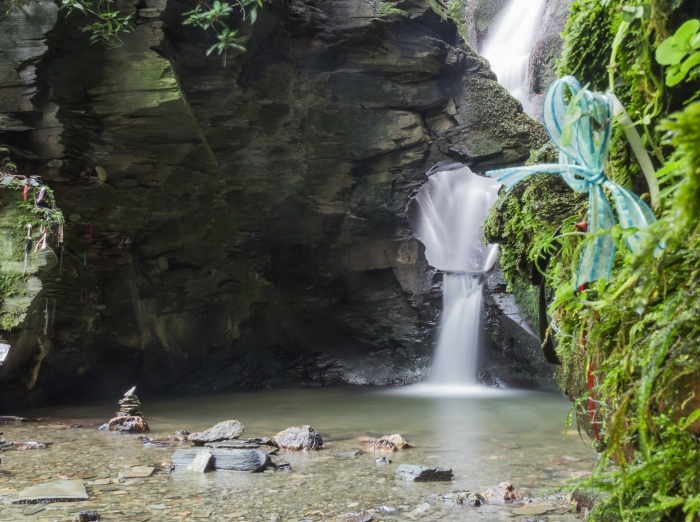It’s rooted in human nature to be drawn to the enclosed and mysterious. Perhaps we’re drawn by our deepest instincts; as towards caves, we are attracted to safe and secluded spots where we can rest and eat. There is too a romantic attraction: we are excited by the prospects of discovering the unknown; we hope to uncover secrets; we are inclined to explore- impelled by curiosity and enticed by the chance of finding something new and previously unseen.

In my recent trip to Cornwall, we made a journey of exploration that had been long promised but never undertaken. Sailing on the ship the Scillonian from Penzance to the Scillies, you pass along the south coast of Penwith; just west of Lamorna is the wooded valley of St Loy. There are houses there, amongst the trees, but there is no public road. We had been lured for many years- and on this trip we finally got there. We parked the car on the edge of the highway and followed a wooded valley by a stream down towards the coast. It felt remote and private- although it was none of these things in all truth, something that was revealed when we reached the expensive residences near the mouth of the valley- where the coast path traverses the cove. Still, it was our adventure; our mission of discovery. The stream cascaded pleasantly down to the sea; there was a private beach- entirely composed of giant boulders, I must admit- but, nonetheless, our beach for which we had worked that morning. The sun was hot and the sea lapped on the rocks and we felt that the decades of waiting had been worth it.
You can stay there in a B&B, and have the beach entirely to yourselves (and the few other residents at night). The drive down the private track, through overhanging trees and round twists and turns, will surely engender the same sense of being explorers in a new and hidden world. There will never be crowds and there will always be seclusion and silence.
Other valleys that I love to explore include:
- Cusop Dingle, just outside Hay on Wye. It’s lined with houses along its length, as the road peters out into the depths of the hills, and a wide and rocky stream tumbles down towards the Wye. You can walk up on the road- but return along the bank and through the fields, with vistas of the town and castle spread before you.

- Holy Vale on St Mary’s, Isles of Scilly. You can reach this by three ways, from the main road down a side road- which is as dull as it sounds; by walking up from the coast through a nature reserve and then into the wooded lower reaches of the valley, which is pleasant or, my favourite, my turning off the road near Sunnyside farm and following a rutted and rocky track down into the Vale. Even on peaceful Scilly, this place seems quiet and out of the way. This has to be a theme and part of the attraction of these spots: it is enclosed, hidden, free from traffic and noise. There has to be the sense of being the first discoverer, of arriving for the here before anyone else has trodden these paths.


- St Nectan’s Glen– another Cornish site, to be found just north along the coast from Tintagel (of purported Arthurian fame). The glen extends on both sides of the main road heading towards Bude. The coast-ward site which is called Rocky Valley and by the National Trust features ruined buildings and rock carved mazes. The upper side is a path which follows the tumbling River Trevillet towards it source. There are three waterfalls, but at the ‘kieve’ at the head of the glen there is an impressive 60′ fall cascading into a pool. Access is through a rather pleasant cafe which has a new age gift shop. The walk is a modest challenge (muddy in wet weather with some slight scrambling involved) but the cafe provides a fitting end, especially the outdoor area surrounded by trees, birds and the sound of the water.

- Luxulyan Valley, mid-Cornwall. A road runs through this from Luxulyan village down to St Blazey, but you have to stop, best near the Trefry viaduct, and climb up the slopes to explore. It’s a remarkable combined landscape or ancient and modern, and it takes my breath away. The valley is littered along its slopes and the river bed with vast boulders. They are concentrated in this one spot, huge and incredible. Amongst these obstacles weaves the remnants of earlier industry- a leet half way up the slope and the bridge, which is in fact an aqueduct with water still running beneath your feet under granite slabs. The whole thing is stunning and overwhelming for the geographical and human scale; man and nature have reshaped the land in amazing ways.

Valleys have always had their special place in art, too, from William Blake’s Vales of Middlesex to Samuel Palmer’s Valley of Vision at Shoreham. His pictures there capture exactly the sense of protection and mystery I am seeking to evoke.
